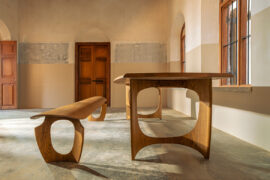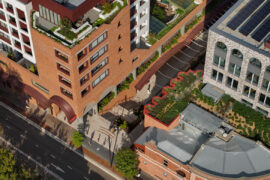Whether it’s enhancing the sculptural volumes of the Cass Bay House, or creating a Piet Mondrian-like geometrical feature across the Pegasus Bay’s Esplanade Home, Neolith helps Massimiliano Capocaccia Architecture Studio augment the imaginative language of these coastal dwellings.

Esplanade House, Christchurch NZ
November 10th, 2022
With sweeping views of Pegasus Bay and calming presence of the nearby mountain range, the Esplanade House epitomises the South Island’s natural character, while its unique personality is revealed through the home’s geometrical envelope. The natural palette effortlessly harmonises with its surroundings, while the assertive squares defining the exterior liken it to an abstract painting.
Further down South, across the axis of Christchurch, the robust volumes of the Cass Bay House spill generously over the slope of the cove. Sympathetically connected to its coastal locale, the somewhat concealed frontage of the residence punctuates the site’s boundary with a highly sculptural, asymmetrical entry sequence.
The common thread underscoring the allure of these New Zealand-based dwellings is the striking external façade. In both cases, it’s Neolith’s distinct qualities that enabled the team at Massimiliano Capocaccia Architecture Studio to achieve some of the homes’ most remarkable attributes.

“We have used Neolith tiles for the façade tile feature on both of these projects because it is a natural product with extraordinary technical characteristics that make it an ideal material for exterior applications,” says Caleb Skene, the practice’s Architectural Graduate. “It comes in big format and only a few mm thickness, adding little weight to the cladding system. It is highly resistant to wear and tear and its low porosity characteristics means it’s easy to maintain and clean which was a considerable reason for its selection in such prominent areas of the homes.”

The Esplanade House comprises two dwellings, with the main home rising high up above the ground to maximise ocean views on every level. Undoubtedly catching the eye of passers-by, the home boasts a timber skin wrapped around its external corner, with fragmented, irregular geometric forms defining all of its openings.
Evoking the memory of Piet Mondrian’s asymmetrical geometry, the architects utilised both the window openings and the Neolith tile to create an artwork-like feature wall. “The Neolith tile creates a powerful contrast to the timber skin façade, defining a strong separation between the two main materials, and allowing the timber skin to be read as a canvas, whilst the windows and tile feature are viewed as geometric shapes, added and subtracted from it.”

The Zaha Stone, Neolith’s stunning, Persian-inspired shade is an homage to Zaha Hadid’s incredible architectural legacy. “It’s a contemporary reinterpretation of Iranian Grey Stone,” explains Kate Deakin-Bell, Neolith’s Marketing Manager APAC. “The Neolith® design team has added a richer, more industrial grey tone with white veins that emphasise the background in opposite directions.” The tiles’ natural photorealistic colouring combines well with the naturally soft characteristics of timber, resonating with the dwelling’s beachside location.

Neolith is generally produced in large format slabs of 5 sqm, however the Esplanade House showcases the product’s incredible flexibility when it comes to achieving custom shapes and sizes. “We played around with many varying geometric compositions before settling on the current design” Caleb says. “It was highly important to us that there were no restraints in the sizes of the Neolith tile, being that they can be cut to varying sizes, because it meant we could form the best and most desired geometric balance without restriction.”
Enhancing the geometry of the Cass Bay House, here, the Neolith large slabs in dark, rich Krater shade were used right by the home’s entrance, helping the architects create the home’s dramatic, almost austere, frontage.

“Entering down the small access lane, you are greeted to the home by three stark volumes that create a distinct demarcation,” Caleb describes. “To the right, a soft vertical timber-lined box with a hidden garage door stands strong and leads you inwards; to the far left a hard Neolith tiled roof and wall contrasts to the soft timber and marks the site boundary, and finally, a sculptural Corten steel portal stands in the centre outlining the entrance point by differentiating against the two strong geometric volumes to either side.”
Caleb adds that the overall exterior design focused on utilising sustainable materials that would sit un-imposingly within the natural surroundings, while defining strong forms. As such, material selection was crucial. “We desired materials which would reflect the landscape, subtly residing within and appreciating the surrounding context,” Caleb adds. “For this we chose to use adobo vertical timber cladding as a reflection of the surrounding foliage, as well as Neolith’s Krater tile as a reflection of the neighbouring rocky shoreline of the bay. The characteristics of natural stone have allowed this reflection to be further emphasised, grounding this project into its environment.”

Specified in large format slabs, the joints are barely perceptible, further enhancing the monumental character of the dwelling’s front façade. At the same time, the substantial size of the panels make them easier to clean, although Neolith tiles are also sprayed with a treatment which creates a photo-catalytic, self-cleaning and decontaminating effect.
“The technology creates self-cleaning surfaces that purify the air,” Kate explains. “Over time, building façades can become dirty and full of contaminating agents that are carried through the air to the surface. When the surface enters into contact with sunlight, titanium dioxide particles are activated and use light energy to transform the moisture in the air into oxidising agents. That, in turn, destroys the nitrogen dioxide particles and contaminating agents and transforms them into water vapour and salt.”

This process is called photocatalysis, and is repeated millions of times each second until all contaminants have been destroyed. “Effectively, the surface is constantly being self-cleaned,” Kate sums up. Yet another invaluable quality which makes Neolith the perfect choice for external applications is the fact that the tiles’ ventilated façade application offers permeability – moving air diffuses water vapour from the inside out and facilitates façade “breathing”, preventing condensation from forming behind the panels.
“Neolith combines the necessary practical and sustainable qualities with an unrivalled attractiveness,” Kate sums up. “The wide range of hyper-realistic colours and patterns help public buildings become iconic focal points that define their surroundings.” That’s undoubtedly the case with both Esplanade and Cass Bay Houses. Neolith tiles helped create sympathetic dwellings that gently emerge from their geographical context, while establishing two distinct, striking and multidimensional architectural personalities.
—
Photographer: Clinton Lloyd
Architect: MC Architecture Studio
Distributor: CDK Stone NZ
We think you might like this story on Neolith’s new way of looking at shapes and spaces
INDESIGN is on instagram
Follow @indesignlive
A searchable and comprehensive guide for specifying leading products and their suppliers
Keep up to date with the latest and greatest from our industry BFF's!

London-based design duo Raw Edges have joined forces with Established & Sons and Tongue & Groove to introduce Wall to Wall – a hand-stained, “living collection” that transforms parquet flooring into a canvas of colour, pattern, and possibility.

Rising above the new Sydney Metro Gadigal Station on Pitt Street, Investa’s Parkline Place is redefining the office property aesthetic.

Sydney’s newest design concept store, HOW WE LIVE, explores the overlap between home and workplace – with a Surry Hills pop-up from Friday 28th November.

Merging two hotel identities in one landmark development, Hotel Indigo and Holiday Inn Little Collins capture the spirit of Melbourne through Buchan’s narrative-driven design – elevated by GROHE’s signature craftsmanship.

Melbourne-based architects Breathe have constructed an unfinished house at the NGV that puts the question of house sizes in Australia on the agenda.

2024’s theme, “Reawaken,” calls for a journey through reinvention and sustainability.
The internet never sleeps! Here's the stuff you might have missed

Architect, designer and craftsman Adam Markowitz bridges the worlds of architecture and fine furniture, blending precision, generosity and advocacy to strengthen Australia’s craft and design community.

Seven years in the making, the new Surry Hills Village is here with doors open and crowds gathering.

Australia’s first planted light rail corridor sets new benchmark for transport-led urban transformation.

Hiwa, the University of Auckland’s six-storey recreation centre by Warren and Mahoney with MJMA Toronto and Haumi, has taken out Sport Architecture at the 2025 World Architecture Festival. A vertical village for wellbeing and connection, the project continues its run of global accolades as a new benchmark for campus life and student experience.